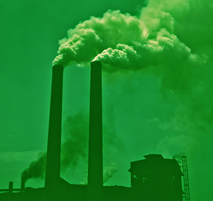Faith in low carbon economic growth
 Financial Times - Investing in a climate change fund may make investors feel good, and it may even make them some money. But connecting environmental responsibility and higher market valuations is a correlation fund managers say has yet to be made.
Financial Times - Investing in a climate change fund may make investors feel good, and it may even make them some money. But connecting environmental responsibility and higher market valuations is a correlation fund managers say has yet to be made. This is a long-term trend, they say, and the cleaner, greener companies will come out as winners in the end.
“Anyone who claims with too much certainty what will be happening in this area is being dishonest, because we really don’t understand everything about climate change yet. As an investment theme it’s more of an insurance against something in the future when you’re making investments now,” says Simon Webber, co-manager of the Schroders Global Climate Change Fund.
So how do fund managers make their investment choices when climate change scientists are still looking for common ground and the rules of play are still being established?
Marc Brammer is the head of ESG business development in Europe for the RiskMetrics Group. He creates screening models and tracks sectors and legislation to see where changes could create costs for companies.
“One of the things about tracking themes like this is understanding where this shift to sustainability is going. And if you think you know where it’s going it’s all about market timing,” says Mr Brammer.
Most funds use one of three screening methods. Negative screening culls the companies involved in businesses some investors may find objectionable, such as tobacco, weapons or alcohol.
Impact screening omits any company deemed to have a negative environmental impact, regardless of their sector. For example, a fund using this approach may avoid a certain manufacturer due to reports that it is polluting a nearby lake.
The third type looks at the impact a business has on the environment and then what costs could be repriced back to the balance sheet in the form of lost contracts, fines or large bills for carbon offset credits. This screening process looks for financial gains or losses related to a company’s environmental impact.
With any of these methods, a company’s share price may not always react to climate change news or developments in environmental laws and practices.
“Most funds are not able to connect environmental or social impact with movement in equity share prices. The movement may be well after the fact,” Mr Brammer says.
Greenpeace last October accused circuit-board maker Kingboard Chemical Group of pumping toxic waste water into the Pearl River. The Hong Kong listed shares of the company showed little reaction to the news, even though the report was widely quoted in the international press.
There are also examples of when shares did move based on a company’s environmental actions, such as the recent drop in shares of Massey Energy following an explosion in its West Virginia coal mine , or the drop in value in Shell shares in 1995 before it reversed plans to scuttle its Brent Spar oil storage facility in the North Sea.
“The reason the market doesn’t move is that it doesn’t understand the science and policies behind climate change, and a lot of this is very qualitative. It appears like a random series of events. There is no consistent way to incorporate the information,” says Mr Brammer. “Where this stuff has value across a portfolio is when it’s about pre-positioning a portfolio.”
Jeremy Higgs is the managing director of Environmental Investment Services Asia. He manages the Green Dragon Fund, which buys shares in companies with significant exposure to the environmental sector and the development of the low carbon economy while shorting shares of companies that managers think will be financially hurt by their poor environmental record.
“I think in years to come these companies will get nailed by the market. It’s not happening so much today, but it will,” Mr Higgs says.
Companies have a great ability to hide costs associated with poor environmental performance, from fines to high carbon offset costs, making it hard to measure these costs.
Investing in a climate change or green fund that buys shares in companies based on the environmental record of their products or operations is comparable to buying a pan-Asian fund in the 1990s, when investors were betting there would be a broad-based economic boom in Asia. There are also similarities to the Bric fad, based on the growth potential of the largest emerging economies of Brazil, Russia, India and China.
“We have a move from a high carbon to low carbon economy, and by default that means we invest in many industries. It’s investing based on the broad belief in low carbon economic growth,” says Mr Higgs.
You can return to the main Market News page, or press the Back button on your browser.

